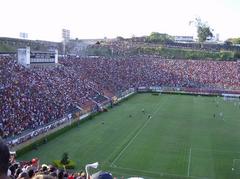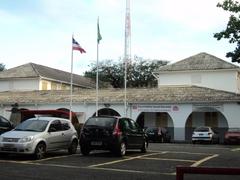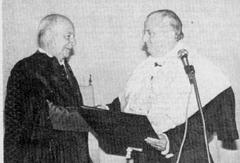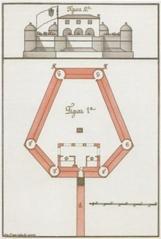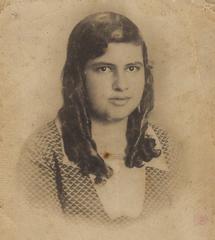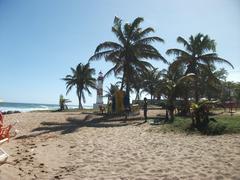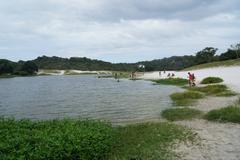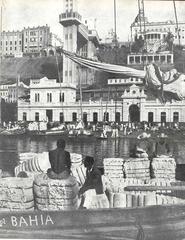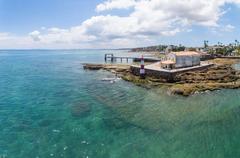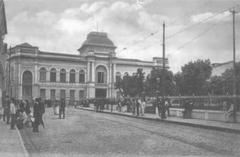Ilê Axé Iyá Omin Iyamassê (Terreiro do Gantois): Visiting Hours, Tickets, and Historical Significance in Salvador, Brazil
Date: 04/07/2025
Introduction
Ilê Axé Iyá Omin Iyamassê, popularly known as Terreiro do Gantois, stands as one of Salvador, Bahia’s most emblematic Candomblé terreiros and a living testament to Afro-Brazilian cultural and spiritual resilience. Founded in 1849 by Maria Júlia da Conceição Nazareth, a freed Yoruba-descendant woman, the terreiro is a vibrant sanctuary for the worship of orixás and a stronghold of ancestral traditions, community cohesion, and resistance. Its matriarchal leadership, architectural layout, and integration of sacred natural elements reflect deep Yoruba cosmology adapted to the Brazilian context.
This in-depth guide provides essential information for visitors—covering historical background, architectural features, visitor etiquette, practical travel tips, and the broader cultural relevance of Terreiro do Gantois. Whether you are a history enthusiast, cultural traveler, or spiritual seeker, understanding the terreiro’s significance and planning your visit with insight into hours, protocols, and accessibility will ensure a respectful and enriching experience (dorispinheiro.com.br, terreirodogantois.com.br, ipatrimonio.org).
Table of Contents
- Introduction
- Historical Foundations and Lineage
- Architectural and Spatial Heritage
- Cultural and Socio-Religious Significance
- Visitor Information: Hours, Tickets, Accessibility
- Visitor Etiquette and Participation
- Festivals and Community Life
- Nearby Attractions and Travel Tips
- FAQs
- Conclusion
- References
1. Historical Foundations and Lineage
Founding and Matriarchal Leadership
Established in 1849 by Maria Júlia da Conceição Nazareth, Terreiro do Gantois embodies the survival and flourishing of Yoruba religious traditions in Brazil amidst slavery and social repression. The terreiro’s site at Alto do Gantois was chosen for its seclusion and spiritual protection during periods of religious persecution. Leadership has always been matriarchal and hereditary, passed through the female descendants—ensuring both bloodline and ritual continuity (terreirodogantois.com.br).
Influential Figures
A defining figure in Gantois history, Mãe Menininha do Gantois (Maria Escolástica da Conceição Nazaré, 1894–1986), served as Iyalorixá (high priestess) from 1922, guiding the terreiro through immense social change and opening its doors to scholars, artists, and the public. Her leadership was pivotal in gaining broader recognition for Candomblé and advancing cultural preservation (Academia.edu).
2. Architectural and Spatial Heritage
Site Location and Layout
The terreiro is located in the Federação neighborhood of Salvador, at R. Mãe Menininha do Gantois, s/n. Its 3,600 m² grounds are carefully organized to facilitate ritual practice and community life, with distinct public, semi-public, and restricted areas (ipatrimonio.org).
Main Temple and Sacred Spaces
At the heart of the terreiro is the barracão (main ceremonial hall), where large gatherings and key rituals take place. Surrounding the barracão are shrines to specific orixás, sacred trees like the gameleira and jaqueira, residential quarters, a sacred kitchen, and memorial spaces such as the Memorial Mãe Menininha do Gantois, which preserves photographs and artifacts from the terreiro’s history.
Architectural Character
The buildings feature simple, whitewashed colonial forms, open courtyards, and natural materials—integrating Afro-Brazilian vernacular styles with practical adaptations for the tropical climate. The harmonious blend of built and natural environments underscores the Candomblé principle of axé—the vital spiritual force present in all living things (ipatrimonio.org).
3. Cultural and Socio-Religious Significance
Heritage Recognition
Ilê Axé Iyá Omin Iyamassê is officially protected as a Cultural and Landscape Area (since 1985) and has been recognized as a National Historic and Ethnographic Heritage Site by IPHAN since 2002 (IPHAN). Its rituals, music, and oral traditions are integral to Salvador’s identity and have shaped broader Brazilian cultural expressions.
Afro-Brazilian Identity and Resistance
Beyond its religious function, the terreiro is a symbol of Afro-Brazilian resistance and affirmation, providing a sanctuary for African-derived religions and fostering respect for Black identity. Its matriarchal structure reflects Yoruba social values, emphasizing kinship and collective responsibility (revistas.usp.br).
Artistic and Educational Role
Terreiro do Gantois serves as a hub for traditional knowledge in music, dance, embroidery, and ritual arts. It regularly hosts workshops, exchanges with international institutions, and educational outreach, sustaining its role as a living center of Afro-Brazilian culture (terreirodogantois.com.br).
4. Visitor Information: Hours, Tickets, Accessibility
Visiting Hours
- Standard Hours: Monday to Friday, 9:00 AM to 5:00 PM
- Exceptions: Hours may change during festivals or special ceremonies; always confirm in advance.
Tickets and Donations
- Entry: There is no fixed ticket fee. Voluntary donations are encouraged to support the terreiro’s upkeep and cultural activities.
Accessibility
The site includes uneven terrain and steps. While main areas are generally accessible, visitors with mobility needs should contact the terreiro ahead of time to arrange assistance (ipatrimonio.org).
Guided Tours
- Availability: Guided tours can be arranged by appointment. These provide valuable context and ensure respectful engagement.
- Booking: Contact the terreiro or use reputable local tour operators for arrangements.
Transportation
- Located in the Federação neighborhood, Gantois is reachable by taxi, rideshare, or public transport. Parking is limited—public transport or rideshare is recommended for convenience.
COVID-19 and Health Protocols
Visitors should verify current health guidelines, as these may affect access and group sizes.
5. Visitor Etiquette and Participation
Dress Code
- Wear modest, clean clothing—long pants or skirts and sleeved shirts.
- White attire is preferred for ceremonies; avoid black, shorts, tank tops, or revealing clothing (G1).
Behavior
- Remain quiet and respectful; avoid loud conversations.
- Greet elders and community leaders politely.
- Do not enter restricted areas or touch sacred objects without permission.
- Non-initiated visitors may observe public rituals but not participate unless invited.
Photography and Filming
- Photography is strictly regulated. Always ask for permission before taking photos, especially during ceremonies or in private spaces.
Offerings and Gifts
- Small offerings (white flowers, candles, food) are appreciated. Monetary donations can be discreetly given to the leadership.
Language and Communication
- Portuguese is the primary language, with Yoruba used in rituals. Arrange a bilingual guide if needed.
6. Festivals and Community Life
Terreiro do Gantois is central to Salvador’s major religious festivals, including the Festa de Iemanjá and Lavagem do Gantois. These events attract thousands, featuring vibrant ceremonies, music, dance, and communal gatherings. They offer unique opportunities for visitors to witness the living traditions of Candomblé (redeglobo.globo.com).
7. Nearby Attractions and Travel Tips
Combine your visit to Terreiro do Gantois with other Salvador landmarks such as Pelourinho, Mercado Modelo, Museu Afro-Brasileiro, and Casa Branca do Engenho Velho. Salvador offers a vibrant culinary and music scene that complements your exploration of Afro-Brazilian heritage.
Plan transportation ahead, especially for evening events, and stay hydrated due to Salvador’s tropical climate.
8. Frequently Asked Questions (FAQs)
Q: What are the terreiro’s visiting hours?
A: Generally, Monday to Friday, 9:00 AM to 5:00 PM, but confirm in advance, especially during festivals.
Q: Is a ticket or donation required?
A: No formal ticket; donations are appreciated.
Q: Are guided tours available?
A: Yes, by prior arrangement.
Q: What should I wear?
A: Conservative, clean clothing; white is preferred for ceremonies.
Q: Is photography allowed?
A: Only with permission, and generally not during rituals.
Q: Is the site accessible for people with disabilities?
A: Terrain can be challenging; contact the terreiro in advance to arrange assistance.
Q: Are children welcome?
A: Yes, but they must behave respectfully.
9. Conclusion
Ilê Axé Iyá Omin Iyamassê (Terreiro do Gantois) is a cornerstone of Salvador’s Afro-Brazilian spiritual and cultural landscape. Its historical depth, matriarchal lineage, and vibrant community life make it a must-visit for anyone interested in the roots and ongoing vitality of Candomblé. By honoring the terreiro’s traditions and protocols, visitors can enjoy a meaningful and respectful experience that goes beyond tourism—connecting with a living legacy of faith, resistance, and cultural pride.
For the latest updates, guided tour bookings, and further information, refer to the terreiro’s official channels and trusted heritage websites. Enhance your journey by downloading the Audiala app and exploring related resources on Afro-Brazilian history and culture.
10. References and Further Reading
- Terreiros de Candomblé e Umbanda de Salvador – Dori Pinheiro
- Terreiro do Gantois – Official Website
- Salvador: Terreiro de Candomblé Ilê Iyá Omin Axé Iyamassê – IPHAN
- Terreiro do Gantois: Salvador da Bahia Tourism Portal
- Casa Branca do Engenho Velho – Geledés
- G1 Bahia: Tips for Visiting Candomblé Terreiros
- Travel Buddies: Candomblé Ceremony Tour from Salvador
- Rede Globo: Festa de Iemanjá 2025


